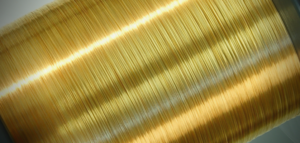Using Copper Tungsten in Die Sinker Electrodes for EDM
Dimensionally a far cry from tungsten wire with a diameter of 0.0010” (0.025 mm) is the use of tungsten for die sinker electrodes. Taking the reverse shape, die sinker electrodes need to be dimensionally robust but also machinable with very fine features — sometimes as thin as fine wire itself. With the capability to produce parts in a myriad of shapes using the die sinker EDM process, Metal Cutting was approached by a customer with a difficult application for aerospace, requiring both a high volume and fine features.
Figuring Out How to Use Ceramic for a Sealing Ring
The customer was tasked with making a new kind of sealing ring to replace the traditional honeycomb rings used on jet engines. The high performance of this new sealing ring would be achieved by using ceramic as the sealing material. The challenge was how to get there — specifically, how to get ceramic into the shape of very large, circular rings.
Ceramic is known for its remarkable wear and high temperature resistance properties. However, it is also known to be brittle and easily chipped. So, to make the customer’s new sealing ring work, the ceramic needed a substrate to hold it in place and provide the foundation and strength it needed, versus having just a pure ceramic ring. The idea came up to utilize fins, a very common feature of jet engine design; however, in this case the fins were purely for adhesion purposes, with ceramic flowed into the spaces between the fins.
Solving a Production Challenge with Copper Tungsten
Of course, engineering the particular kind of ceramic for its duty purpose and flowing it into the fins was its own challenge. But for the purpose of those of us in the metals business, our challenge was to make the fins — and not just a few of them, but thousands and thousands of identical fins that needed to be made in segments and match up with the various descending circumferences required for this application. How would it be possible to machine these tall and thin fins with deep channels separating them by only a fraction of a millimeter?
The solution was to make the fins using EDM die sinking electrodes. These electrodes are made using very precise ratios of evenly distributed and perfectly uniform copper tungsten. However, normal production doesn’t require this new application’s higher level of powder consistency and distribution, as well as the necessary homogeneous density throughout the entire electrode block. In addition, the electrodes for this application were going to be very large and each one needed to be mated perfectly to the ones adjoining it.
Ensuring the Right Foundation for EDM
(Spoiler alert: You might want to stop reading if you have a fear of flying or of going to the dentist.)
Imagine you are flying in a jet plane and from your seat, you have a direct view straight into one of the engines. Surely you are hoping that small pieces of metal will not be ejected from inside the engine!
What’s that got to do with CuW used in die sinker electrodes for EDM cut-off of fins for ceramic sealing rings? There is a domino effect in that, if the primary EDM electrode material had oversized, unblended chunks of metal or undetected voids, the resulting fin pattern would have gaps and be missing design features that are necessary to supporting and affixing the ceramic. That is why such close attention needed to be paid to the consistency, distribution, and homogeny of the CuW use in this application.
It’s a bit like dentistry and having a crown put in. No matter how good the crown looks, if the underlying work wasn’t done properly — if the crown and base were not shaped correctly, not enough adhesive was used, or there were gaps in the crown’s seal — then the ability to use the tooth repeatedly will be compromised. Likewise, the integrity of the sealing ring and the ceramic surrounding it started with this foundation, which was created by an EDM process that relied on the perfect starting material.






